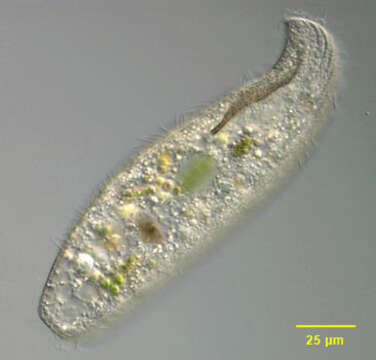portrait

Description:
Portrait (left side) of Loxodes striatus, a medium-size karyorelict ciliate. Loxodes striatus is colorless to slightly brown. The cell body is elongate, rounded anteriorly and posteriorly and highly laterally compressed. The anterior is bent ventrally forming a short beak-like rostrum. Very flexible. Somatic ciliature on the left side is restricted to a marginal kinety. On the right surface there are regular longitudinal kineties. In this species there are longitudinal pellicular striations on the left surface. The slit shaped cytostome is located in a ventral concavity posterior to the rostrum. A thin cone of dark fibrils forms a primitive cytopharynx at the posterior end of the cytostome (seen here). There are two spheroid macronuclei, one anterior and one in the mid body, each with an adherent micronucleus (neither seen well in this image). The arrangement of the macronuclei and the pellicular striations distinguish L. striatus from the similar L. vorax and L. rostrum. Refractile concretions of barium sulfate occupy several Müller's vesicles on the dorsal side. These probably act as statoreceptors, orienting the organism in the gravitational field. There are also subcortical pigment granules, which may have chemo- and phototactic functions. Found in polysaprobic habitats. Feeds on cyanobacteria, algae, flagellates and other ciliates. From organically enriched freshwater pond sediment near Boise, Idaho. DIC optics.
Included On The Following Pages:
- Life (creatures)
- Cellular (cellular organisms)
- Eukaryota (eukaryotes)
- SAR (Stramenopiles, Alveolates, Rhizaria)
- Alveolata (alveolates)
- Ciliophora (ciliates)
- Postciliodesmatophora
- Karyorelictea
- Loxodida
- Loxodidae
- Loxodes
- Loxodes striatus
This image is not featured in any collections.
Source Information
- license
- cc-by-nc
- author
- William Bourland
- provider
- micro*scope
- original
- original media file
- visit source
- partner site
- micro*scope
- ID


